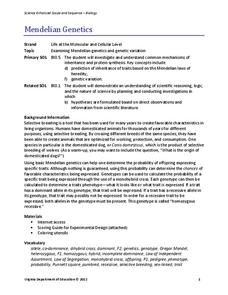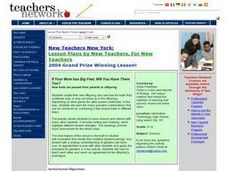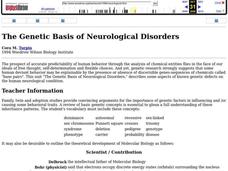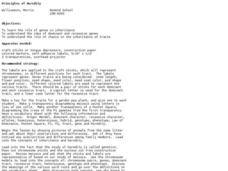Curated OER
Dragon Genetics - Understanding Inheritance
Six pages begin with a detailed introduction to meiosis and homologous chromosome pairs. Instructions guide learners through a simulation in which they draw craft sticks marked with autosomes in order to decode the genes inherited by...
Curated OER
Biology-Genetics
Students predict the probable mode of inheritance from a pedigree diagram showing phenotypes. They study the genetic basis for Mendel's laws of segregation and independent assortment. They give a Power Point slide show demonstrating the...
Curated OER
AP: Chapter 14: Mendel and the Gene Idea
A survey of Mendelian genetics is presented through this handout. Biology prodigies answer questions about the Law of Segregation, phenotypic ratios, and dominance. They define genetics vocabulary terms and describe various genetic...
Palomar College
Crossword Puzzle for Basic Principles of Genetics
In this genetics worksheet, learners complete a crossword puzzle by determining the terms associated with the 24 clues given. Students review terms such as phenotype, genotype, alleles, and Mendel.
Curated OER
Genetics Mendelian
High schoolers explore genetic terms, the Law of Dominance and the contributions of Gregor Mendel. After discussing Mendel's lab and his pea plants students observe examples of a phenotype chart. Afterward, they conduct their own lab to...
Curated OER
Introduction to Mendelian Genetics using Fiction
Students investigate Mendelian Genetics by studying the history of Mendel and what it was like to be a 19th century scientist. They read a pieces of fiction during this investigation.
Curated OER
Mendel and Meiosis
In this meiosis worksheet, students review vocabulary words associated with genetics, fertilization, heredity, phenotype and genotype. This worksheet has 6 matching and 9 fill in the blank questions.
Curated OER
Dragon Genetics Lab-Principles of Mendelian Genetics
Students study genetic traits using popsicle sticks as chromosomes. In this biology lesson, students explain how traits are inherited from parents. They differentiate dominant and recessive genes.
Curated OER
Variety is the Spice of Life
Learners explore Gregor Mendel's work with genetics. They complete a survey of their friends and family in order to identify dominant and recessive traits. Once their surveys are complete, students discuss the ways in which dominant...
Curated OER
Human Heredity Traits
Completing an idea map based on various inheritance factors and mistakes, 9th graders review their knowledge of genetic disorders. While the activity is based on chapter 15 of an unnamed textbook, the questions at the bottom of the page...
Curated OER
Let's Get Square
Students predict possible phenotypic and genotypic outcomes for avariety of common plant hybrids. They review and explain the characteristics of dominant and recessive traits and explore Mendelian genetics. Students plot the possible...
Curated OER
Mendelian Genetics
Students work collaboratively in small learning groups to create some representation of an aspect of Mendelian genetics in this review instructional activity for the Biology classroom. The instructional activity includes task cards for...
Curated OER
Mendel and Meiosis
In this meiosis worksheet, students review Mendel's process of the passing on of traits to the next generation. This worksheet has 3 short answer questions
Curated OER
Mendellian Genetics
Young scholars describe the inheritance patterns other than simple dominance. They are taught how Mendel's principles apply to all organisms. Students review the use of Punnett Squares. They are taught the principles of probability...
Curated OER
Heredity Worksheet #1
For this genetics worksheet, students review the experiments on pea plants that Mendel used to explain dominant and recessive alleles. This worksheet has 10 fill in the blank questions.
Curated OER
Genome's Greatest Hits
High schoolers explore the progression of discoveries that have led to the genetics knowledge that scientists currently have. In groups, students research scientists that have made important contributions to understanding the molecules...
Curated OER
Punnett Squares/Genetics
Ninth graders complete a monohybrid cross and a dihybrid cross. In this biology lesson, 9th graders predict the traits of offspring using the Punnett square. They differentiate recessive and dominant genes.
Curated OER
If Your Mom Has Big Feet, Will You Have Them Too?
Learners describe and apply the Mendellian principles of genetics, focusing predominantly on dominant and recessive genes. They demonstrate how two parents contribute genes and how those genes appear in their offspring. They describe...
Curated OER
Designer Babies
Students differentiate phenotypes and genotypes. In this genetics instructional activity, students complete the punnett square. They design their own baby by choosing the phenotype they want.
Curated OER
The Genetic Basis of Neurological Disorders
Students describe some aspects of known genetic defects on the human neurological condition. They participate in a variety of exercises including drawings, games, and analogies.
Curated OER
The Genetic Basis of Neurological Disorders
Students explore neurological disorders. They examine the presence and absence of discernible genes. Students describe neruological diseases and draw faces of affected persons. They play a human neurology disorders learning game.
Curated OER
Disproving the Proof
Students investigate the progression of discoveries that have led to the genetics knowledge that scientists currently have. They determine how genetic experiments disproved previous theories on inheritance.
Curated OER
Principles of Heredity
Students model traits on genes using colored paper and tongue depressors to represent chromosomes. In this heredity lesson plan, students use their "chromosome sticks" to understand chromosome pairs, genes, dominant traits, recessive...
Curated OER
World-wide Search for the Dominant Trait
Learners receive instruction on dominant/recessive traits, access World-Wide Search for the Dominant Trait and download information on which traits to assess. They collect data on at least 20 people and prepare a data chart.

























